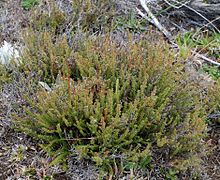Erica galioides
| Erica galioides | |
|---|---|

| |
| Scientific classification | |
| Kingdom: | Plantae |
| Clade: | Tracheophytes |
| Clade: | Angiosperms |
| Clade: | Eudicots |
| Clade: | Asterids |
| Order: | Ericales |
| Family: | Ericaceae |
| Genus: | Erica |
| Species: | E. galioides
|
| Binomial name | |
| Erica galioides | |
| Synonyms[1] | |
|
Eleutherostemon galioides (Lam.) Klotzsch
| |
Erica galioides is a species of flowering plant (angiosperms) in the heather family (Ericaceae). It is endemic to the island of Réunion in the Indian Ocean.[1]
Habitat
[edit]Erica galioides is the found above the treeline in the mountains of Réunion. It is present in subalpine dry ericaceous shrubland from 2200 to 2700 meters elevation, with Erica reunionensis, Agarista buxifolia, Stoebe passerinoides, Hypericum lanceolatum, Phylica nitida, Sophora denudata, Senecio hubertia, S. squamosus, Psiadia argentea, P. callocephala, P. anchusaefolia, Costularia melicoides, Festuca borbonica, and Agrostis salaziensis, and in alpine open dwarf scrub and semi-desert from 2700 to 3000 meters elevation with Stoebe passerinoides, Festuca borbonica, Poa borbonica, Agrostis salaziensis, Pennisetum caffrum, and Grimmia spp.[2]
References
[edit]- ^ a b "Erica galioides Lam.". Plants of the World Online, Kew Science. Accessed 29 August 2021. [1]
- ^ Leuschner, Christoph (1996). "Timberline and Alpine Vegetation on the Tropical and Warm-Temperate Oceanic Islands of the World: Elevation, Structure and Floristics". Vegetatio, Vol. 123, No. 2 (Apr., 1996), pp. 193-206. Accessed 11 August 2021. Stable URL: https://www.jstor.org/stable/20048667
